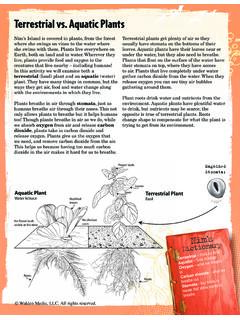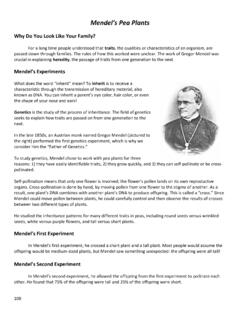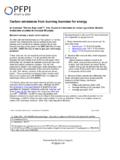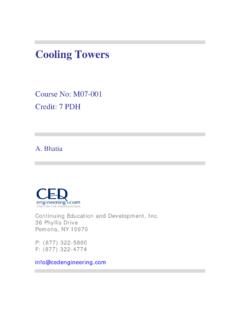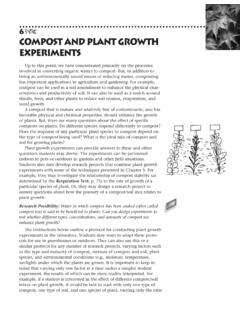Transcription of Land-Use Requirements of Modern Wind Power Plants in the ...
1 Technical Report NREL/TP-6A2-4 5834 August 2009 Land-Use Requirements of Modern Wind Power Plants in the United States Paul Denholm, Maureen Hand, Maddalena Jackson, and Sean Ong National Renewable Energy Laboratory 1617 Cole Boulevard, Golden, Colorado 80401-3393 303-275-3000 NREL is a national laboratory of the Department of Energy Office of Energy Efficiency and Renewable Energy Operated by the Alliance for Sustainable Energy, LLC Contract No. DE-AC36-08-GO28308 Technical Report NREL/TP-6A2-45834 August 2009 Land-Use Requirements of Modern Wind Power Plants in the United States Paul Denholm, Maureen Hand, Maddalena Jackson, and Sean Ong Prepared under Task No. NOTICE This report was prepared as an account of work sponsored by an agency of the United States government. Neither the United States government nor any agency thereof, nor any of their employees, makes any warranty, express or implied, or assumes any legal liability or responsibility for the accuracy, completeness, or usefulness of any information, apparatus, product, or process disclosed, or represents that its use would not infringe privately owned rights.
2 Reference herein to any specific commercial product, process, or service by trade name, trademark, manufacturer, or otherwise does not necessarily constitute or imply its endorsement, recommendation, or favoring by the United States government or any agency thereof. The views and opinions of authors expressed herein do not necessarily state or reflect those of the United States government or any agency thereof. Available electronically at Available for a processing fee to Department of Energy and its contractors, in paper, from: Department of Energy Office of Scientific and Technical Information Box 62 Oak Ridge, TN 37831-0062 phone: fax: email: Available for sale to the public, in paper, from: Department of Commerce National Technical Information Service 5285 Port Royal Road Springfield, VA 22161 phone: fax: email: online ordering: Printed on paper containing at least 50% wastepaper, including 20% postconsumer waste i Acknowledgments Substantial assistance in preparing this analysis, including the land-cover data, mapping, as well as general advice and guidance, was provided by Donna Heimiller, Anelia Milbrandt, and Billy Roberts at the National Renewable Energy Laboratory (NREL).
3 Additional graphics and editorial support were provided by Jim Leyshon and Michelle Kubik. ii Table of Contents Acknowledgments .. i 1 Introduction ..1 2 Wind Power Plant Land-Use Metrics ..1 Direct Impact Area ..4 Total Wind Plant Area ..4 3 Wind Power Plant Land-Use Data ..5 Direct Impact Area ..6 Total Wind Plant Area ..6 Wind Power Plant Land-Cover and Configuration Data ..6 4 Results ..9 Summary Results ..10 Direct Impact Area Results ..11 Total Area Results ..13 5 Alternative Area Metrics and Measurement Methods ..20 Habitat Impact Area ..21 Uniform Estimation of Total Area Requirements ..21 6 Conclusions ..22 References ..24 iii List of Figures Figure 1. Illustration of the two types of wind plant land use: total area and direct impact area (including permanent and temporary) ..3 Figure 2. Example of direct impact area ..6 Figure 3. Examples of wind Power plant configurations.
4 8 Figure 4. Locations of wind Power Plants evaluated in this Figure 5. Distribution of permanent direct impact area ..11 Figure 6. Distribution of temporary direct impact area ..12 Figure 7. Distribution of total area Requirements ..14 Figure 8. Distribution of total area expressed as capacity density ..15 Figure 9. Direct impact area Requirements (hectare/MW) as a function of wind Power plant size ..19 Figure 10. Capacity density as a function of wind Power plant size ..20 Figure 11. Possible methodologies for assigning uniform land metrics to total area of wind Power Plants ..22 List of Tables Table 1. Summary of Collected Wind Power Plant Area Data ..10 Table 2. Projects with Detailed Direct Impact Data ..13 Table 3. Distribution of Direct Impact Area ..13 Table 4. Wind Power Plant Configuration ..16 Table 5. Land-Cover Data ..17 Table 6. Relationship between Configuration and Land-Use Area.
5 18 Table 7. Relationship between Land-Cover and Average Land-Use Area ..18 Table 8. Relationship between Land Cover and Configuration ..19 Table 9. Direct impact area Requirements (hectare/MW) as a function of wind Power plant size ..19 1 1 Introduction By the end of 2008, a combination of environmental, economic, and policy factors resulted in the cumulative deployment of more than 25 gigawatts (GW) of wind generation capacity in the United States (AWEA 2009a). Continued growth is anticipated due to renewable portfolio standards and expected constraints on carbon emissions in the electric sector. One of the concerns regarding large-scale deployment of wind energy is its potentially significant land use. Estimates of land use in the existing literature are often based on simplified assumptions, including Power plant configurations that do not reflect actual development practices to date.
6 Land-Use descriptions for many projects are available from various permitting agencies and other public sources, but we are not aware of any single source that compiles or summarizes this data. In addition, there is limited information comparing land use for wind Power Plants across different terrain and plant configurations. The existing data and analyses limit the effective quantification of Land-Use impacts for existing and future wind energy generation, particularly in comparison to other electricity generation technologies. In this report, we provide data and analysis of the land use associated with Modern , large wind Power Plants (defined as greater than 20 megawatts (MW) and constructed after 2000). We begin by discussing standard Land-Use metrics as established in the life-cycle assessment literature, and then discuss their applicability to wind Power Plants . We identify two major classes of wind plant land use: 1) direct impact ( , disturbed land due to physical infrastructure development), and 2) total area ( , land associated with the complete wind plant project).
7 We also provide data for each of these classes, derived from project applications, environmental impact statements, and other sources. We also attempt to identify relationships among land use, wind plant configuration, and geography. We evaluated 172 existing or proposed projects, which represents more than 26 GW of capacity. In addition to providing Land-Use data and summary statistics, we identify several limitations to the existing wind project area data sets, and suggest additional analysis that could aid in evaluating actual land use and impacts associated with deployment of wind energy. 2 Wind Power Plant Land-Use Metrics There are a number of existing and proposed metrics for evaluating Land-Use impacts. While there is no generally accepted methodology (Canals et al. 2007), review of the life-cycle assessment (LCA) literature suggests at least three general categories for evaluating Land-Use impacts: 1) the area impacted, 2) the duration of the impact, and 3) the quality of the impact (Koellner and Scholz 2008).
8 In this report, we focus on quantifying and summarizing the first component of Land-Use impact identified above (area of impact), recognizing that the quality and duration of the impact must be evaluated on a case-by-case basis. The quality of impact, which may also be stated as a damage function, evaluates both the initial state of the land impacted, and 2 the final states across a variety of factors including soil quality and overall ecosystem quality (Koellner and Scholz 2008). Quantifying the area of a wind Power plant is challenging given the discontinuous nature of its configuration. Area includes not only land directly disturbed by installation of the turbines, but also the surrounding area that potentially may be impacted. In reviewing various environmental impact assessments and other evaluations of wind plant land use, it appears that there are two general types of areas considered.
9 The first is the direct surface area impact ( , disturbed land) due to plant construction and infrastructure. The second is more vaguely defined, but is associated with the total area of the wind Power plant as a whole. Figure 1 provides a simplified illustration of the two types of areas, which are vastly different in both quantity and quality of impacts as discussed in subsequent sections. 3 Figure 1. Illustration of the two types of wind plant land use: total area and direct impact area (including permanent and temporary)1 1 The total project area map is adapted from an actual project application ( DOE 2005). The direct impact area is a simplified illustration meant to represent typical components and does NOT represent this or any actual project. 4 Direct Impact Area Development of a wind Power plant results in a variety of temporary and permanent (lasting the life of the project) disturbances.
10 These disturbances include land occupied by wind turbine pads, access roads, substations, service buildings, and other infrastructure which physically occupy land area, or create impermeable surfaces. Additional direct impacts are associated with development in forested areas, where additional land must be cleared around each turbine. While land cleared around a turbine pad does not result in impervious surfaces, this modification represents a potentially significant degradation in ecosystem quality (Arnett et al. 2007). In addition to permanent impacts, which last the life of the facility, there are temporary impacts from plant construction. These impacts are associated with temporary construction-access roads, storage, and lay-down. After plant construction is completed, these areas will eventually return to their previous state. The amount of time required to return to its pre-disturbance condition is estimated at two-three years for grasslands and decades in desert environments (Arnett et al.)










